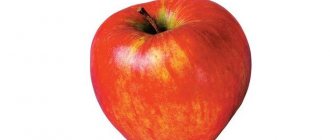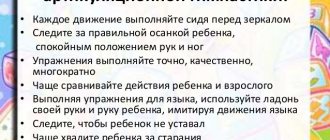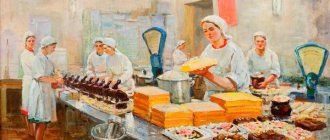Theme “Vegetables and fruits” (repetition)
Goals:
— activation of the dictionary on the topic; - practical preparation of a simple common sentence; - practical mastery of gender agreement between an adjective and a noun; - development of attention and memory.
Equipment:
dummies of vegetables and fruits, pictures of “vegetables” and “fruits”.
Progress of the lesson
1. Organizational moment.
Game exercise “What is this?” (with a ball). “A tomato is... a vegetable. An apple is... a fruit” (the child answers).
2. Compose a simple common sentence.
Game “Where did it come from? What did you bring?” First, the speech therapist carries a tomato, cucumber, and beetroot in a basket. He asks: “Tell me, where did I come from, what did I bring?” Children should answer: “You came from the garden, brought vegetables.” (You came from the garden, brought fruit.) Then the children select vegetables or fruits for themselves in the basket and ask the other children the same question.
3. Distinguishing the concepts of “vegetables and fruits”.
Dunno comes to visit. He asks the children to sort out his basket, which contains mixed vegetables and fruits. The speech therapist invites children to put fruits from the basket into a vase and vegetables onto a tray. A child comes out, takes, for example, a cucumber from the basket and says: “A cucumber is a vegetable. I put it on the tray. (An orange is a fruit. I put it in a vase).”
4. Physical education (cut out of cardboard). Children stand scattered in a group. The instruction is given: “If our operator (child) shows us a fruit on TV, then we all jump, if it’s a vegetable, we squat.”
5. Agreeing adjectives with nouns in gender.
Game exercise “What am I up to?” There are pictures on the easel: apple, turnip, tomato. “What did I say – round, round, round?” On the easel: radish, apple, tomato. “What did I say - red, red, red?”
6. Fixing the material.
"What's left?" On the easel: cucumber, peach, pear. One child stands with his back to him. Two items are removed. To guess which one is left, the child must ask at least three questions. “Is this a fruit? Is it round? Does it have velvet skin? There's a peach left." At the same time, the children answer his questions in unison, but only “yes” or “no.”
7. Summary of the lesson. "
What did they talk about in class?
HOUSE AND ITS PARTS
Topic “House and its parts” (lesson No. 1)
Goals:
— expansion of the dictionary on the topic; - practical mastery of antonyms; — word formation: verbs with different prefixes; - singular and plural nouns.
Equipment:
collapsible house, toy - kitten.
Progress of the lesson
1. Organizational moment.
"Who lives where?". The speech therapist asks questions: “Where does the squirrel live? Where does the bird live? Where does the bunny live? Where does the bee live? Reads a poem:
A fish in the river, a mole in a hole. Everyone lives somewhere. A hare in the field, a mouse in the straw. I live in a brick house. But the cat Murka has nowhere to live, she needs to build a house for her. She gave birth to kittens, and she needs an apartment.
2. Introduction to the topic.
The speech therapist and the children assemble a house from parts, discuss all the details: first - the foundation, then - the walls, roof, porch, windows. What else does the house have? (Ceiling, floor, attic, chimney...) The house is ready, the door is open. Now is the time to move in.
3. Word formation.
Murka decided to see what kind of house they built for her. The speech therapist leads a kitten - a toy. All actions are discussed by the children. “Murka came up to the house, walked around the house, walked away from the house, admired the new house, and entered the house. What was Murka doing?
4. Physical education minute.
Game “I walk around the house.”
Children walk in circles around the house
And I look through the windows,
the first child walks around the circle, looking into the windows.
I’ll go up to one and knock softly,
knock-knock.
Who’s there?
- It’s me, Sasha, they are running around the circle in different directions.
Let’s go and run,
who will take the place faster
5. Formation of the plural of nouns.
Game "One - Many".
Pipe - pipes wall - walls attic - attics Door - doors floor - floors corner - corners Ceiling - ceilings window - windows roof - roofs Frame - frames staircase - stairs
6. Practical mastery of antonyms.
Game "On the contrary" (with a ball).
The walls are thick - the walls are thin, the ceiling is high - the ceiling is low. The windows are wide - the windows are narrow, the floor is clean - the floor is dirty. The house is small - the house is large, the porch is low - the porch is high.
7. Summary of the lesson.
Game "Chain". We name the parts of the house.
Topic “House and its parts” (lesson No. 2)
Goals:
— activation of the dictionary on the topic; - practical mastery of relative adjectives; - Difficult words; - writing a simple sentence.
Equipment:
ball, pictures - houses of different heights.
Progress of the lesson
1. Organizational moment.
"We're building a house." Children stand in a circle. The child starts the game with a ball in his hands. "I will build the foundation." Passes the ball to whomever he wants. Whoever has the ball continues the game. "I will build walls" ...
2. Formation of relative adjectives.
Let's remember the fairy tale "The Three Little Pigs". “What material were the piglets’ houses made of? - Made of straw, twigs, stone. In which house did they escape from the wolf? - In stone. Why? - It is the most durable. What do people use to build strong houses for themselves? - Made of brick, wood, panels, blocks. We need to give the piglets some advice. What kind of houses are best to build to protect them from cold and wind? — I will advise building brick houses. “I will advise the piglets to build block houses (panel, wooden, stone).”
Physical education minute.
All day long, knock and knock, knocking fist against fist
There is a loud knock.
We are building a house, a big house, arms to the sides, up
And with a porch, and with a chimney,
hands at the chest, at the top
We will decorate the house,
paint
At the top we will nail a flag,
on the fingers there is a flag
They will live in that house,
put their palms to their heads, then their fists
Bunny with bear and elephant,
arms forward, palms connected
4. Formation of complex words.
“Houses differ not only in the material from which they are made, but also in height. What kind of houses are there? “Low, high, high.” The speech therapist says that she lives in a house with two floors. She lives in a two-story house. “What houses do you live in?” Children remember how many floors there are in their house and, with the help of a speech therapist, form the words: three-story, four-story, five-story...
5. Summary of the lesson.
Homework: look and count how many floors there are in your house. What material is it made of?
Topic “House and its parts” (lesson No. 3)
Goals:
- an exercise in composing a simple common sentence; - use of a preposition between
; - development of mental processes.
Equipment:
cards, a house made of building material (three floors, each with three apartments), toys.
Progress of the lesson
1. Organizational moment.
“Tell me, what house do you live in? (homework)". For example, I live in a five-story brick building.
2. Development of fine motor skills.
Exercises “Walls”, “Ceiling”, “Door Opens”, “Roof”.
3. Development of logical thinking.
“We’ll move the house.” Each child needs to fill out a card so that identical figures do not end up next to each other. They quarreled and don't want to live together. Next is the children's story. For example: “On the third floor I have a tick, a dot, and a stick. On the second floor there is a dot, a stick and a tick. And on the first one there is a stick, a tick and a dot.”
Physical education minute.
We run up the stairs and count the floors, running in place
One floor, two floors, three, four,
jumping in place
We are in the apartment.
turning around
5. Using the preposition between.
"Housewarming in a new house." Children are invited to help settle new residents in a new home. Children place three toys on each floor. Next, you need to tell who was accommodated on the first, second, third floor. But first we need to talk about the first and third apartments, and then about the second. For example: “I occupied the first floor. Dogs now live in the first apartment, and Cheburashka in the third. And between them, in the second apartment, there is Gena the crocodile, etc.”
6. Summary of the lesson.
CLOTH
Topic “Clothing” (lesson No. 1)
Goals:
— activation and expansion of the dictionary on the topic “Clothing”; - ability to ask questions independently; - mastering possessive nouns; - development of attention, memory, thought processes.
Equipment:
subject and cut-out pictures depicting clothes, dolls, doll clothes.
Progress of the lesson
1. Organizational moment:
“Let the one with the red shirt (blue shorts, green dress, white tights, etc.) sit down.”
2. Development of fine motor skills.
Exercises for fingers “Putting on gloves”: massage each finger from the nail to the base, first on one hand, then on the other, starting with the little finger.
3. Introduction to the topic.
Two dolls are displayed in front of the children - one dressed and one undressed. The speech therapist asks questions: “How are these dolls different? Why does a person need clothes? Object pictures on the topic are displayed and named. It is proposed to name the clothes that are not in the pictures. “How can we call these objects in one word? (Cloth)".
4. Development of mental processes.
Game “Remember and name in order.” Children are offered 5-6 pictures of items of clothing to memorize, then without visual support they must list them. Options:
1) Several object pictures are displayed in front of the child. The speech therapist lists them without naming one. The child must determine which of the pictures was not named.
2) The child is called one more picture than is displayed in front of him. He must determine which picture is missing.
5. Physical school.
6. Use of possessive pronouns.
The speech therapist invites children to choose from the presented subject pictures those about which we can say:
Mine is a fur coat, jacket, blouse, skirt, shirt, etc.; Mine is a sundress, suit, sweater, jacket, raincoat, etc.; Mine are pants, shorts, socks, tights, mittens, etc.; Mine - dress, coat, underwear.
7. Development of perception and spatial concepts.
Game "Add the pictures." Each child is given a cut-out picture on the topic “Clothing”. He must collect this picture and name the object depicted on it.
8.
Game "Guess what I wished for." The speech therapist takes a picture of an item of clothing without showing it to the children, and the children, using leading questions, try to guess the item of clothing. The child who guesses first becomes the leader of the game.
9. Fixing the material.
Game "Let's help Olya and Kolya." “We need to pack our things for the trip for Olya and Kolya. Here is Olin’s suitcase, and this is Colin’s suitcase.” Each child takes one item and determines whose clothes it is and whose suitcase it needs to be put in. “This dress is for Olya, Olya’s dress. This is a sweater for Kolya, Colin’s sweater.”
10. Summary of the lesson.
“What did they talk about today? What are the clothes for?
Topic “Clothing” (lesson No. 2)
Goals:
- expansion and activation of the dictionary, - practical use of the names of clothing parts; - formation of diminutive forms of nouns; — practicing phrases using nouns in the accusative case.
Equipment:
subject pictures, outline of clothing for frontal work, cut-out pictures, toy telephone.
Progress of the lesson
1. Organizational moment: formation of the plural of nouns.
The speech therapist throws the ball to the child and names the item of clothing in the singular, and the child in the plural: skirt - skirts, shirt - shirts, jacket - jackets, dress - dresses, but... trousers, shorts. Option: each child has a cut-out picture of clothes on the table. Game "Fold the picture."
2. Development of fine motor skills:
“Let’s put on gloves” (see lesson No. 1).
3.
The speech therapist calls two children to the board, and the whole group examines and names the name of the part of their clothing.
4. Fixing the material.
Game “Who can name the most pieces of clothing?” The group is divided into two teams, representatives are selected who name the details of the clothing. The rest of the children count the number of named objects.
5. Physical school: children imitate getting ready for a walk with their movements.
6. Practicing the phrase.
The speech therapist puts out a sheet of paper with a drawn outline of an item of clothing. Children take turns going to the board and finishing drawing some detail, voicing their actions, for example: “I drew a pocket, etc.”
7. Formation of the diminutive form of nouns.
The speech therapist tells the children about the magical land of Gnome, where little people live. You can call them on the phone and tell them what the details of clothing are called in ours and in theirs: “We have a collar, and you have a collar” (frill, shoulder strap, pocket, fold, etc.).
8. Summary of the lesson.
Children name the details of clothing in a chain, repeating the previous word and adding their own.
Topic “Clothing” (lesson No. 3)
Goals:
— expansion and activation of the dictionary; - practical use of relative adjectives; - use of antonyms in speech; - development of thought processes.
Equipment:
object pictures, samples of different types of fabric, the game “Atelier” - the outline of clothing for frontal work, cut-out pictures, a toy telephone.
Progress
1. Organizational moment.
Ball game “Say kindly” (name of clothing details).
2. Formation of relative adjectives.
The speech therapist says that a package has arrived with various fabrics so that we can sew beautiful clothing models for the exhibition. But first you need to repeat the names of the fabrics. For example: drape. And the conversation about fabrics follows the following pattern: “What quality fabric is this? What types of clothing is it used for? What can you sew from drape? What will this thing be called?
3. Physical education minute.
It is held in the form of a game between two teams. “Who can fasten the buttons on a doll’s clothes faster?”
4. Consolidation of new material.
Game "Atelier" (or "Exhibition"). Each child takes a piece of fabric and a suitable picture of clothing. The speech therapist asks the question: “What clothes will he make from this fabric? What will these clothes be called? You can give a sample story: “I will make a coat from drape. It will be a drape coat.”
5.
Game “Guess what clothes I have in mind?” The speech therapist hides one picture, describes it, and the children guess what is shown in this picture.
6. Summary of the lesson.
“What did we learn about in class today? What products did we make for the exhibition?” (Drape coat, cotton jacket, wool jacket, silk blouse, denim shorts, wool sundress, etc.)
Topic “Clothing” (lesson No. 4)
Goals:
— expansion and activation of the dictionary on the topic “Clothing”; - development of coherent speech, - clarification of the concepts “put on - put on.”
Equipment:
subject and subject pictures, doll, doll clothes.
Progress of the lesson
1. Organizational moment.
Children stand in a circle, the speech therapist offers to sit down for those who have something red (blue, green, black) in their clothes. Children must name the color and item of clothing.
2.
The speech therapist's conversation about how the doll Katya is going for a walk. It is necessary to help the doll get dressed, and the speech therapist offers each child the choice of putting some item of clothing on it. The child goes to the board, chooses clothes and discusses his actions: “We’ll put tights on Katya (blouse, jumper, sweater, scarf).” Generalization: we put something on (on...), we dress... (someone).
3. Fixing the material.
The demonstration canvas displays plot pictures, on one of which a girl or boy is dressed, on the other a child puts on something. The speech therapist asks: “Which pictures can we say “dress” and which ones can we say “put on”?”
4. Physical education minute:
1) Masha put on a mitten. “Oh, where am I going? My finger is missing, I’m missing, I didn’t get to my little house.” Masha took off her mitten. “Look, I found it.”
2) Children go out into a circle and sit on the rug. The speech therapist asks one child to leave the group, and the rest of the children must remember what clothes the child is wearing.
5. Development of coherent speech, composing a story based on pictures.
The speech therapist suggests coming up with a name for the doll and packing it up for a walk. He asks questions about what we will put on the doll and where it will go for walks. A story is composed of 3-4 sentences.
6.
The story is repeated by two or three children.
7. Summary of the lesson.
“What did we learn in class?” - “We learned to say words correctly”
Didactic games for preschoolers 4-6 years old on the topic: Fruits, vegetables, berries
Didactic games for preschoolers on the topic: “Fruits, vegetables, berries”
Author: Knis Anna Nikolaevna, senior teacher. Place of work: MBDOU “Kindergarten No. 3 “Smile”, Kalach - on - Don. Description of work: I bring to your attention didactic games for preschoolers on the topic: “Fruits, vegetables, berries.” This material will help educators, children and their parents consolidate children's knowledge about fruits, vegetables and berries in a playful way. Didactic game “The fifth odd one” Goal: Development of skills to classify objects according to essential characteristics, consolidation of generalization words. Didactic material: Cards depicting five objects, four of them belong to one thematic group, and the fifth to some other group. Progress of the game: Children are given the task: “Look at the pictures, name what is depicted on them and determine which object is superfluous. Name the remaining items in one word.” Each participant eliminates the extra item in turn. If he makes a mistake or does not complete the task, his version is offered to the next player to complete. For each correctly completed task they give a chip. The one who collects the most chips wins. Cards for the game: 1. Strawberry, raspberry, kiwi, blackberry, currant. The extra kiwi is because it is a fruit and the rest are berries.
2. Tomato, eggplant, pepper, potato, banana. The extra banana is because it is a fruit and the rest are vegetables.
3. Gooseberries, peach, cranberries, currants, blueberries. The extra peach is because it is a fruit and the rest are berries.
4. Kiwi, apple, pear, peach, tomato. The extra tomato is because it is a vegetable and the rest are fruits.
5. Oranges, apples, radishes, lemon, banana. The extra radishes are because they are vegetables and the rest are fruits.
6. Pear, radish, garlic, cucumber, cabbage. The extra pear is because it is a fruit and the rest are vegetables.
Didactic game “Shop “Fruits, Vegetables, Berries” Goal: Developing children’s skills to accurately describe the appearance (color, shape), taste, and place of growth of fruits, vegetables and berries. Didactic material: Models of fruits, vegetables and berries. Progress of the game: Children choose a seller. The buyer approaches the table on which the models are laid out. Without naming, he describes the fruit, vegetable or berry he wants to buy. For example: “I want to buy berries. They grow in the forest on small bushes. The berries are small, dark blue, round, like peas, slightly flattened on top, juicy and sweet. Jam and compote are prepared from these berries” (blueberries). The child must describe the selected item in such a way that the seller understands what he wants to buy. The seller sells fruits, vegetables and berries (gives the dummy) only to those who have completed the task correctly. Didactic game “Whether in the garden or in the vegetable garden” Purpose: To develop children’s skills to accurately determine the place where fruits and vegetables grow. Didactic material: Pictures of fruits and vegetables, a picture of a vegetable garden and a picture of a garden. How to play: 2 children or 2 groups of children play. The teacher gives one child (group) a picture of a vegetable garden, and another child (group) a picture of a garden. Pictures of fruits and vegetables are laid out in front of the children. A child (group) who has a picture of a garden is collecting vegetables, and a child (group) who has a picture of a garden is collecting fruits. At the end of the game, children check with each other whether they completed the task correctly. Task options: - one group comes up with a riddle about vegetables or fruits, and the other group must find and show the answer in the picture; - tell what can be prepared from vegetables (fruits).
We recommend watching:
Didactic games (verbal) for children 5-6 years old Didactic game for children 5-6 years old Didactic game for teaching literacy to older preschoolers Didactic game for teaching literacy to older preschoolers
Similar articles:
Games to develop motor coordination for children 5-7 years old
Didactic games with natural materials for older children in kindergarten
Educational games for children 5-6 years old in kindergarten
Didactic games to familiarize yourself with flora and fauna for children of the senior preparatory group
Didactic games to familiarize yourself with the outside world in the preparatory group
notes on vegetables and fruits lesson plan on the world around us (preparatory group)
Municipal budgetary preschool educational institution
“Combined kindergarten No. 24 “Bee”
Abstract of GCD on cognitive development for children 6-7 years old
On the topic: “Vegetables and fruits”
Developed by: teacher
Elkina O.A
Target. Strengthen children's knowledge about the benefits of vegetables and fruits, their importance for human health
Tasks. Educational. Develop storytelling skills based on a picture. Learn to compose descriptive monologue statements using a diagram. Exercise children in the formation of cognate words. Enrich children's knowledge about vegetables and fruits. Developmental. Develop children's horizons and interest in riddles. Educational. Cultivate politeness.
Integration of areas: “Communication”, “Health”, “Cognition”, “Reading fiction”
Equipment: illustrations of “vegetables” and “fruits”, dummies (vegetables and fruits), a wonderful bag.
Progress of NOD (Organizational moment).
Educator: Children, when people meet, they always say hello. The word “hello” means “be healthy.” So we wish you all good health:
Hello, the sky is blue
Hello, golden sun, Hello, Mother Earth, Hello, my friends.
Educator: - Where did the children harvest? (children's answers) - What grows in the garden? (children's answers) - And if we need to harvest fruit, where will we go? (children's answers) - What grows in the garden?
Children's answers. Educator: I will start our lesson today with riddles. In order to guess them, you need to listen to them carefully. Are you ready? Children's answers. Guess the riddles:
| I am orange, juicy, I am healthy and tasty, Ogorodnikov’s love, And my name is... (carrot.) | Here's another mystery. She grew up in the garden. We use it for lunch, cook borscht and vinaigrette. So rosy and round, And useful to us... (beets.) |
| It’s unprepossessing, a little bumpy, and when it comes to the table, the guys will say cheerfully: “Well, it’s crumbly, delicious!” Soup and cabbage soup, mashed potatoes, okroshka, We need it everywhere... (potatoes) | It looks like a cucumber, And just as well done, Warms its barrel with the sun, Juicy, tasty... (zucchini) |
| Rounder and redder than everyone else, It tastes best in salads, And the guys have been loving it for a long time... (tomato) | It's pimply, green, delicious, fresh and salty. Tomato is a friend and brother, The salad is so good with them! This slender fellow is crispy, thin... (cucumber) |
| Very bitter - but useful! Protects against diseases! And he is not a friend to microbes - Because it is ... (bow) | He saved us from colds, He added vitamins to us, And he helped us from the flu, Our bitter doctor... (garlic) |
| He looks like a red ball, but he doesn’t gallop. It contains a useful vitamin, It is ripe... (orange) | Far in the south somewhere It grows in winter and summer. The Thick-skinned One will surprise us...(pineapple) |
| A yellow oval fruit, it lives in sunny countries, but it tastes sour, And his name is... (lemon) | The fruit looks like a tumbler and wears a yellow shirt. Breaking the silence in the garden, fell from the tree... (pear) |
| Children know this fruit, monkeys love to eat it. He comes from hot countries, and his name is... (banana) | In the summer in a green dress, and in the fall - in purple. Fragrant and beautiful. Do you recognize? This is... (plum) |
| Adults love it, And little children love it, The round, rosy sides of a ripe...(apple) | Pear, apple, banana, pineapple from hot countries. These delicious products, Together they are all called... (fruits) |
Educator: Well done! You are all very attentive and smart. They guessed carrots, cabbage, onions, and peppers. But how can all this be called, in one word? Answers from children. Educator: Correct. It is about them that we will talk today “Vegetables” Conversation Educator: How many of you know how vegetables differ from fruits? (Children’s answers) Educator: Where do vegetables grow? Children’s answers. Educator: What is the name of the profession of a person who grows vegetables? Children's answers. Educator: What are vegetables for? Children's answers: (Vegetables are needed in order to eat them) Educator: What can be prepared from vegetables? Children's answers: (Salad, borscht, cabbage soup, fry, eat raw, etc.). There are vegetables (or dummies) on the table. Game “What’s missing?” Children close their eyes. The teacher removes one of the vegetables, the children open their eyes and answer what is missing. Game “Wonderful Bag” The teacher puts dummies of vegetables into an opaque bag. Children take turns recognizing vegetables by touch. Educator: Well done! Which one of you likes to eat vegetables? Answers from the children. Educator: Guys, vegetables are very healthy, they contain a lot of vitamins. You definitely need to eat them. But before you eat them, you need to do a very important thing. Which one? Children's answers. Educator: Correct. Educator: Now you know everything about vegetables.
Game “Which vegetable?” (Children are shown pictures of vegetables and are asked to characterize them): Onion - bitter, white, aromatic, round; Carrots are orange, long, sweet, tasty, healthy, etc.
Educator: Now you know everything about vegetables, their color and shape. I suggest sitting down at the tables and drawing your choice of “Vegetables” or “Fruits”.
Physical education
| Let's go to the garden and the garden. We will collect the harvest. | Walking in place (or in a circle) |
| Apples and pears were picked from the tree, And they collected it in a basket. | Hands up Hands down |
| We found garlic Quickly collected from the garden | Tilt down, arms down. Straightened up. |
| Brother onion grows nearby, It will come to our basket | Tilt down, arms down. Straightened up. |
| And we need carrots, they are very tasty. | Tilt down, arms down. Straightened up. |
| But you can’t lift the cabbage, One, two, three, four, five. | Sit down, hands forward, Stand up. |
| We collected all the harvest, and we walked home. | Walking in place (or in a circle) |
Auto-training: I eat vegetables and fruits - These are the best products. They will save us from all diseases. There is nothing tastier and healthier. I make friends with vegetables, And with salads and cabbage soup. There are countless vitamins in them.
So you need to eat it!
Summing up the lesson.
Reflection:
Educator: Children, what do you remember most, did you like it? What new did you learn? You did a good job today - you solved riddles, learned a lot of interesting things about fruits and vegetables and their benefits. This concludes the lesson for the senior group.




